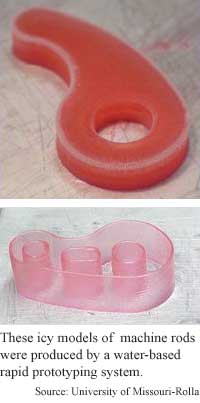
Freezing speeds rapid prototyping
By Eric Smalley, Technology Research NewsCombine ice sculptures, inkjet printers and CAD software and you've got the makings of a more rapid, rapid prototyping system.
Researchers at the University of Missouri-Rolla have developed Ice Rapid Prototyping, a technique that turns CAD data into 3-D models by spraying droplets of water in a freezing chamber.
"We were thinking of using material which is inexpensive and clean. These days we're thinking of the environment," said Ming Leu, professor and director of the university's Virtual and Rapid Prototyping Laboratory.
Typical rapid prototyping systems use lasers to harden photosensitive polymers, creating three-dimensional forms in vats of liquid plastic. Leu's technique is faster because water flows more quickly than liquid plastic and is hardened by temperature rather than exposure to a lightbeam.
The Ice Rapid Prototyping system renders the exterior shell of an object with water droplets sprayed from a jet much like those used in inkjet printers, Leu said. "For the interior we can fill in with a constant stream of water, which is much faster than just using water droplets," he said.
Also, adding dyes to the water makes it possible to produce objects or individual parts of objects in color.
The obvious drawback to the system is that its output has a tendency to melt. "In the other methods you can keep the part on a shelf… forever," said Leu. Objects produced by the Ice Rapid Prototyping system can be used to make molds, which in turn can be used to produce longer lasting versions of the objects, he said.
The system can also be used to make ice sculptures, he added.
The Ice Rapid Prototyping system is still in the early part of its development phase, Leu said.
"A major challenge is how to find support or sacrificial material," he said. "If you want to build a complex part -- let's say a part with an overhang -- you've got to have something to support it. [And] later on you've got to be able to remove it."
The researchers are also working on improving the system' s accuracy and speed.
"When the water droplet is coming out, it tends to spread out and also freeze at the same time. So there is interaction between the heat transfer and fluid mechanics. That's pretty challenging," Leu said.
Ice Rapid Prototyping could be commercially viable in two to three years, said Leu. The research was funded by the State of Missouri.
Timeline: 2-3 years
Funding: Government
TRN Categories: Data Representation
Story Type: News
Related Elements: Photo
Advertisements:
September 27, 2000
Page One
Ants solve tough problems
Camera gets all the exposure
Coated specks form nano building blocks
Sturdy virus makes tiny container
Freezing speeds rapid prototyping

News:
Research News Roundup
Research Watch blog
Features:
View from the High Ground Q&A
How It Works
RSS Feeds:
News
Ad links:
Buy an ad link
| Advertisements:
|
 |
Ad links: Clear History
Buy an ad link
|
TRN
Newswire and Headline Feeds for Web sites
|
© Copyright Technology Research News, LLC 2000-2006. All rights reserved.